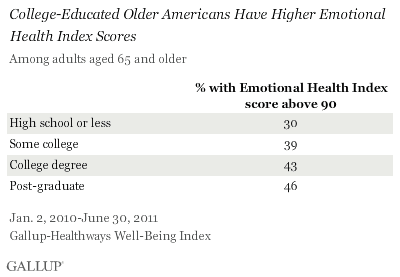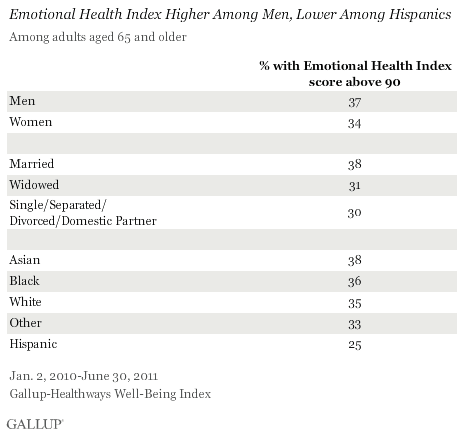This is part two in a special series about emotional health and aging in America. examined the relationship between age and emotional health. Other articles will explore the factors that best predict better emotional health among those aged 65 and older.
WASHINGTON, D.C. -- Older Americans with a college education are significantly more likely to be emotionally well-off than are people in this age group with less education. Among those aged 65 and older, these results hold even after statistically controlling for gender, race, marital status, employment, satisfaction with standard of living, and regional location.

The emotionally well-off are defined as individuals whose scores on the Gallup-Healthways Emotional Health Index are above 90, out of a maximum of 100. The Emotional Health Index is based on a comprehensive measure of emotional well-being asking Americans whether they felt "a lot of" each of the following emotions the day before the survey: smiling/laughing, learning/doing something interesting, being treated with respect, enjoyment, happiness, worry, sadness, anger, and stress. Among those aged 65 and older, 35% score above 90.
Men Do Well, Hispanics Suffer, and Marital Status Means Little
Older men are slightly more likely than older women to score above 90 on this composite measure of emotional well-being, even after statistically keeping all other variables constant. Among racial and ethnic groups, older Hispanics are the least likely to have Emotional Heath Index scores above 90, and this difference persists after holding all other variables constant.
Being married does not appear to improve older Americans' emotional health. The apparent lack of a "marriage advantage" may be explained, at least in part, by the fact that marital status alone does not take into account the quality of the relationship or other related factors.

Bottom Line
Older Americans with a college education have higher Emotional Health Index scores than do people in this age group who have less education, even after controlling for various factors. The results do not indicate whether a given demographic characteristic, such as having a college education, leads to higher emotional well-being or whether individuals with a propensity to be emotionally positive are more likely to pursue more education. , the results suggest the advantages of a college degree extend well beyond one's professional life and potential income. As such, education may provide individuals with skills and knowledge critical to managing their emotions in later years.
In addition, the Emotional Health Index scores reveal that on the surface being married is not necessarily emotionally beneficial to those aged 65 and older. Further, the results indicate that widows and widowers are not emotionally worse off than others, suggesting that the loss of a spouse in one's older years may not be as devastating as one would think. At the same time, the length of marriage, quality of the relationship, and other related factors may be more important to emotional health than the mere fact of being married.
About the Gallup-Healthways Well-Being Index
The Gallup-Healthways Well-Being Index tracks U.S. and U.K. well-being and provides best-in-class solutions for a healthier world. To learn more, please visit .
Frank Newport contributed to this article.
Survey Methods
Results are based on telephone interviews conducted as part of the Gallup-Healthways Well-Being Index survey Jan. 2, 2010-June 30, 2011, with a random sample of 520,267 adults, aged 18 and older, living in all 50 U.S. states and the District of Columbia, selected using random-digit-dial sampling.
For results based on the total sample of national adults, one can say with 95% confidence that the maximum margin of sampling error is 卤1 percentage point.
Margins of error for subgroups have a maximum margin of sampling error of 卤3 percentage points.
Interviews are conducted with respondents on landline telephones and cellular phones, with interviews conducted in Spanish for respondents who are primarily Spanish-speaking. Each sample includes a minimum quota of 400 cell phone respondents and 600 landline respondents per 1,000 national adults, with additional minimum quotas among landline respondents by region. Landline telephone numbers are chosen at random among listed telephone numbers. Cell phone numbers are selected using random-digit-dial methods. Landline respondents are chosen at random within each household on the basis of which member had the most recent birthday.
Samples are weighted by gender, age, race, Hispanic ethnicity, education, region, adults in the household, and phone status (cell phone only/landline only/both, cell phone mostly, and having an unlisted landline number). Demographic weighting targets are based on the March 2010 Current Population Survey figures for the aged 18 and older non-institutionalized population living in U.S. telephone households. All reported margins of sampling error include the computed design effects for weighting and sample design.
In addition to sampling error, question wording and practical difficulties in conducting surveys can introduce error or bias into the findings of public opinion polls.
For more details on Gallup's polling methodology, visit .
